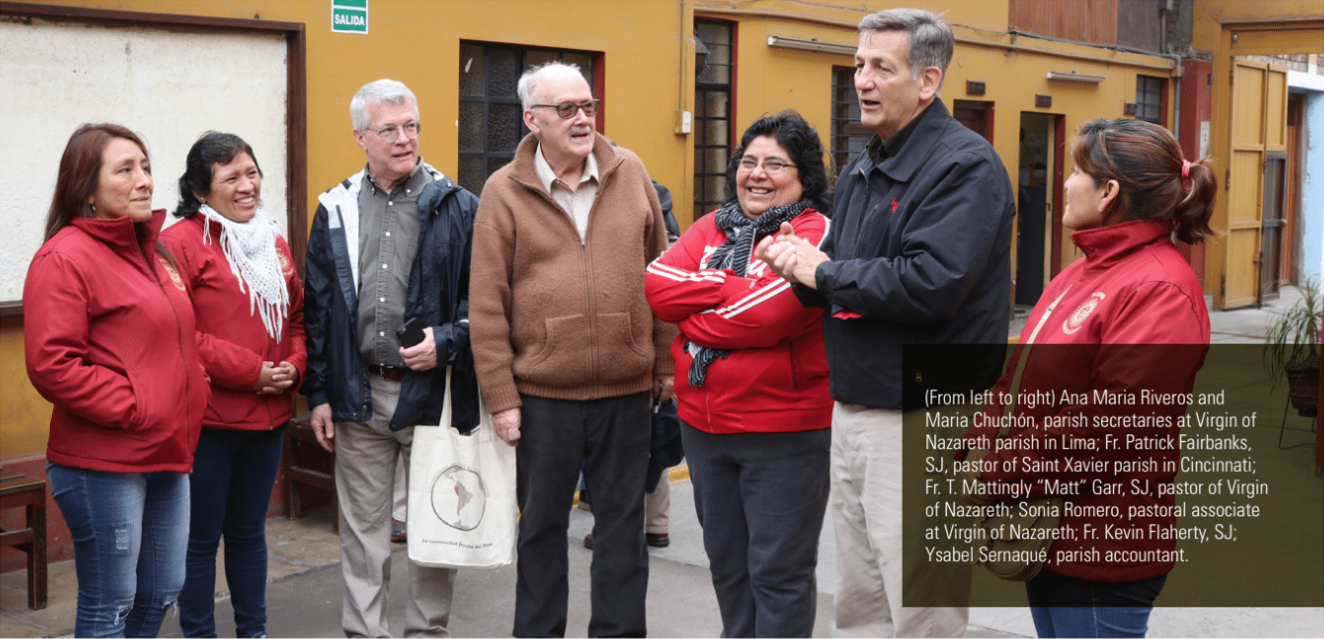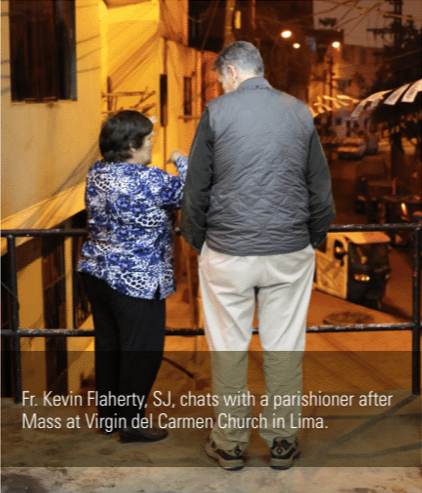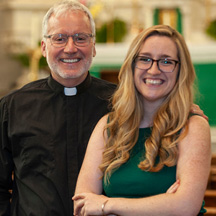When Fr. T. Mattingly “Matt” Garr, SJ, first arrived in Lima, Peru, in 1965 for college studies as a 20-year-old Jesuit in formation, he thought of it as “more of an adventure than anything else.” That adventure turned into a lifetime of accompanying the people of Peru.

Today, he serves as the pastor of Virgin of Nazareth Parish, founded by the Jesuits in 1968 and located in the El Agustino neighborhood of Lima. Father Garr estimates that the parish, which includes seven local chapels, has 100,000 people living nearby and serves as many as 5,000 people a year through spiritual and social programs.
While Peru is considered to have a “middle level” economy, most of its people still exist at or below the poverty line, and there are great needs in the areas of nutrition, health, education, and housing, Fr. Garr explains.
Jesuits in Peru serve and accompany the people in a variety of ways: they’ve founded schools and administered parishes, spirituality centers, and radio stations. They maintain social centers in urban areas, and they also serve the rural and indigenous communities in the Andes and the Amazonian forests.
Looking to the future, Fr. Garr says that one important frontier is developing cooperation—
colaboración—among Jesuits and laypeople. “We are working together on one mission: that of God and the Kingdom. Our task as Jesuits is to share our spirituality so that these laypeople can be the people who actually run our ministries.”
One such lay person is Lauren De Veau, who first came to Peru in 2013 to work at a PEBEAL (Basic Alterative and Labor [technical] Education Program),
a Jesuit organization dedicated to serving the Pamplona Alta neighborhood in Lima. Today, she works at Antonio Ruiz de Montoya University, which was established by the Jesuits in Peru in 2003. De Veau founded the language center there and currently teaches ethics and citizenship and is director of the Office of Global Engagement.
De Veau, who has a bachelor’s in theology and a master’s in social justice from Loyola University Chicago, describes her work as building bridges between continents, provinces, districts, and social classes. “I’m grateful for the opportunity to witness others, particularly from a more privileged background like the US, and bear witness to the beauty, grit, and strength of Peru, particularly the students,” she says. “Peru and Peruvians have taught me how to redefine beauty, success, and entitlement.”
60 Years of Collaboration
The Jesuits of Peru are present in almost all the geographic regions of Peru and offer pastoral, social, and educational ministries, and the Midwest and Peruvian Jesuits’ relationship dates back to 1958. One Midwest Jesuit, Fr. Kevin Flaherty, SJ, has worked in Peru for more than 25 years over the course of his life.
As a Jesuit in formation, Fr. Flaherty taught high school and coordinated mission trips to poor areas of the country from 1977 to 1980. He returned to the country in 1987, serving at Virgin of Nazareth Parish until 1992.
Fr. Flaherty returned to Peru in 1996 as the spiritual director of the Jesuits’ formation program, accompanying priests, sisters, and lay ministers in therapy and spiritual direction, and giving retreats and workshops until 2012. After returning to Peru once again at the beginning of this year, Fr. Flaherty now does counseling, spiritual direction, teaching, workshops, and retreats, while helping in El Agustino on weekends.
“Much of my work is dedicated to the formation of priests and sisters and assisting in the development of a Church that strengthens the faith of the people and promotes social justice for all of Peru’s people,” Fr. Flaherty explains.
Reciprocity is a strong feature of the Midwest Jesuits’ relationship with Peru, as cross-province assignments and trainings provide an opportunity for both Midwest and Peruvian Jesuits to improve language proficiency and deepen the sense of solidarity between the provinces.
The Society’s priorities in the country have always included an option for the poor and reconciliation work—especially among the people who have experienced terrorism and government oppression, Fr. Garr explains.
“The people of El Agustino endured 20 years—an entire generation, from 1980 to 2000—of terrorist attacks by Marxist insurgents, and they fled to the parish buildings for safety,” Fr. Garr says. “We (the Jesuits) did whatever we had to do to keep people from starving in the streets. We established communal kitchens and people brought whatever food they had to share. The parish really grew up in relationship to the terrible social situation in the city.”
At Peru’s Frontier
For Fr. Flaherty, the greatest challenge of working in Peru is seeing the effects of poverty in the lives of those he accompanies. “Economic poverty can wreak havoc on families and communities. It takes a toll not only on those who suffer its consequences, but also on those who minister to the poor in so many areas of Peru.”
“Peru is a frontier in the sense that there is so much to be done,” he says. For example, there are currently 400,000 Venezuelan economic refugees in the country, and the Jesuits are responding to their needs as well.
“Seven million of the 30 million Peruvians live on, or less than, three dollars a day,” Fr. Flaherty says. “There are great challenges in the development of adequate systems of local democracy, education, health, and housing. The Peruvian Church has some beautiful colonial churches, yet there is a shortage of priests and a great need to strengthen the participation and leadership of lay Catholics.”
Despite the challenges, Fr. Flaherty finds joy in his work—especially in the people. “I love them and their desire to continue to struggle for a better life. My favorite place to celebrate liturgy is a poor chapel in El Agustino where I accompany families that I’ve known for 30 years ago. The experience of sharing in the lives of the poor is an ongoing invitation to discover how God is with us.”
Return to the Jesuits Magazine Fall/Winter 2018 Magazine Index





